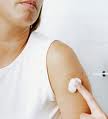 Women who measure their peak heart rates for exercise will need to do some new math, as will physicians giving stress tests to patients. A new formula based on a large study from Northwestern Medicine provides a more accurate estimate of the peak heart rate a healthy woman should attain during exercise. It also will more accurately predict the risk of heart-related death during a stress test.
Women who measure their peak heart rates for exercise will need to do some new math, as will physicians giving stress tests to patients. A new formula based on a large study from Northwestern Medicine provides a more accurate estimate of the peak heart rate a healthy woman should attain during exercise. It also will more accurately predict the risk of heart-related death during a stress test.
“Now we know for the first time what is normal for women, and it’s a lower peak heart rate than for men,” said Martha Gulati, MD, assistant professor of medicine and preventive medicine and a cardiologist at Northwestern Medicine. “Using the standard formula, we were more likely to tell women they had a worse prognosis than they actually did.” Gulati is the lead author of a study published June 28 in the journal Circulation.
“Women are not small men,” Gulati added. “There is a gender difference in exercise capacity a woman can achieve. Different physiologic responses can occur. ” Gulati was the first to define the normal exercise capacity or fitness level for women in a 2005 study.
The old formula -- 220 minus age -- used for almost four decades, is based on studies of men. The new formula for women, based on the new research, is 206 minus 88 percent of age. At age 50, the original formula gives a peak rate of 170 beats per minute for men and women. The new women’s formula gives a maximum heart rate of 162 beats for women. Many men and women use their peak heart rate multiplied by 65 to 85 percent to determine their upper heart rate when exercising.
“Before, many women couldn’t meet their target heart rate,” Gulati said. “Now, with the new formula, they are actually meeting their age-defined heart rate.” The new formula is trickier to calculate, Gulati acknowledged, but is easily determined with a calculator. She currently is working on an iPhone application for a quick calculation.
The new formula is based on a study of 5,437 healthy women ages 35 and older who participated in the St. James Women Take Heart Project, which began in the Chicago area in 1992. With the new formula, physicians will more accurately determine if women are having a normal or abnormal response to exercise. “If it’s abnormal, that’s a marker for a higher risk of death,” Gulati said. “Maybe we need to talk about whether you exercise enough and what we need to do to get it into the normal range.
“We need to keep studying women to get data applicable to women,” Gulati said. “It’s important to not get complacent that we have data on men and assume women must be the same. They’re not.”
Gulati’s senior author on the study was the late Morton Arnsdorf, MD, professor emeritus and associate vice chairman of medicine and former section chief of cardiology at the University of Chicago.

 An article was released in the June 10, 2010 edition of the well-respected journal, Nature, that raises the question of doing research studies on pregnant women. Women get colds, the flu, infections and other diseases during their pregnancies that have nothing to do with their mom-to-be status. Many women simply "toughen it out" hoping their condition is just a virus that will run its course. Other times, they rely on their obstetrician's experience with other patients who may have been prescribed an antedote that the physician has used successfully in her/his practice, but has not actually been studied in well-designed research studies that included pregnant women.
An article was released in the June 10, 2010 edition of the well-respected journal, Nature, that raises the question of doing research studies on pregnant women. Women get colds, the flu, infections and other diseases during their pregnancies that have nothing to do with their mom-to-be status. Many women simply "toughen it out" hoping their condition is just a virus that will run its course. Other times, they rely on their obstetrician's experience with other patients who may have been prescribed an antedote that the physician has used successfully in her/his practice, but has not actually been studied in well-designed research studies that included pregnant women. According to the World Health Organization, alcohol is one of the most significant risk factors for diseases including chronic conditions like cancer, diabetes, and heart disease. Compared with men, women become more cognitively impaired by alcohol and are more susceptible to alcohol-related organ damage. Women develop damage with less intake and over a shorter period of time than men. When men and women of the same weight consume equal amounts of alcohol, women have higher blood alcohol concentrations. This is due in part because women have proportionately more body fat and a lower volume of body water compared with men of similar weight. This leads to women having a higher concentration of alcohol because there is less volume of water to dilute the alcohol.
According to the World Health Organization, alcohol is one of the most significant risk factors for diseases including chronic conditions like cancer, diabetes, and heart disease. Compared with men, women become more cognitively impaired by alcohol and are more susceptible to alcohol-related organ damage. Women develop damage with less intake and over a shorter period of time than men. When men and women of the same weight consume equal amounts of alcohol, women have higher blood alcohol concentrations. This is due in part because women have proportionately more body fat and a lower volume of body water compared with men of similar weight. This leads to women having a higher concentration of alcohol because there is less volume of water to dilute the alcohol. according to researchers at the Johns Hopkins Bloomberg School of Public Health. They examined published data from numerous adult and child vaccine trials and found that sex is a fundamental, but often overlooked predictor of vaccine response that could help predict the efficacy of combating infectious disease. The review is featured in the May 2010 issue of The Lancet Infectious Diseases.
according to researchers at the Johns Hopkins Bloomberg School of Public Health. They examined published data from numerous adult and child vaccine trials and found that sex is a fundamental, but often overlooked predictor of vaccine response that could help predict the efficacy of combating infectious disease. The review is featured in the May 2010 issue of The Lancet Infectious Diseases.
 In recognition of Poison Prevention Week (March 14-20), the Center for Disease Control (CDC) is highlighting the growing issue of unintentional drug poisoning in the United States. More than 26,000 deaths from unintentional drug poisoning occurred in the U.S. in 2006. Opioid pain medications (e.g., oxycodones and methadone) were involved in more than half of these deaths. In recent years, this cause of death has more than doubled between 1999 and 2006. In 2006, 17,740 drug overdose deaths occurred among males and 8,660 among females. Male rates exceed females rates in every age group. However, male rates have doubled and female rates have nearly tripled since 1999. In response to this growing problem the CDC has developed an issue brief titled
In recognition of Poison Prevention Week (March 14-20), the Center for Disease Control (CDC) is highlighting the growing issue of unintentional drug poisoning in the United States. More than 26,000 deaths from unintentional drug poisoning occurred in the U.S. in 2006. Opioid pain medications (e.g., oxycodones and methadone) were involved in more than half of these deaths. In recent years, this cause of death has more than doubled between 1999 and 2006. In 2006, 17,740 drug overdose deaths occurred among males and 8,660 among females. Male rates exceed females rates in every age group. However, male rates have doubled and female rates have nearly tripled since 1999. In response to this growing problem the CDC has developed an issue brief titled 
